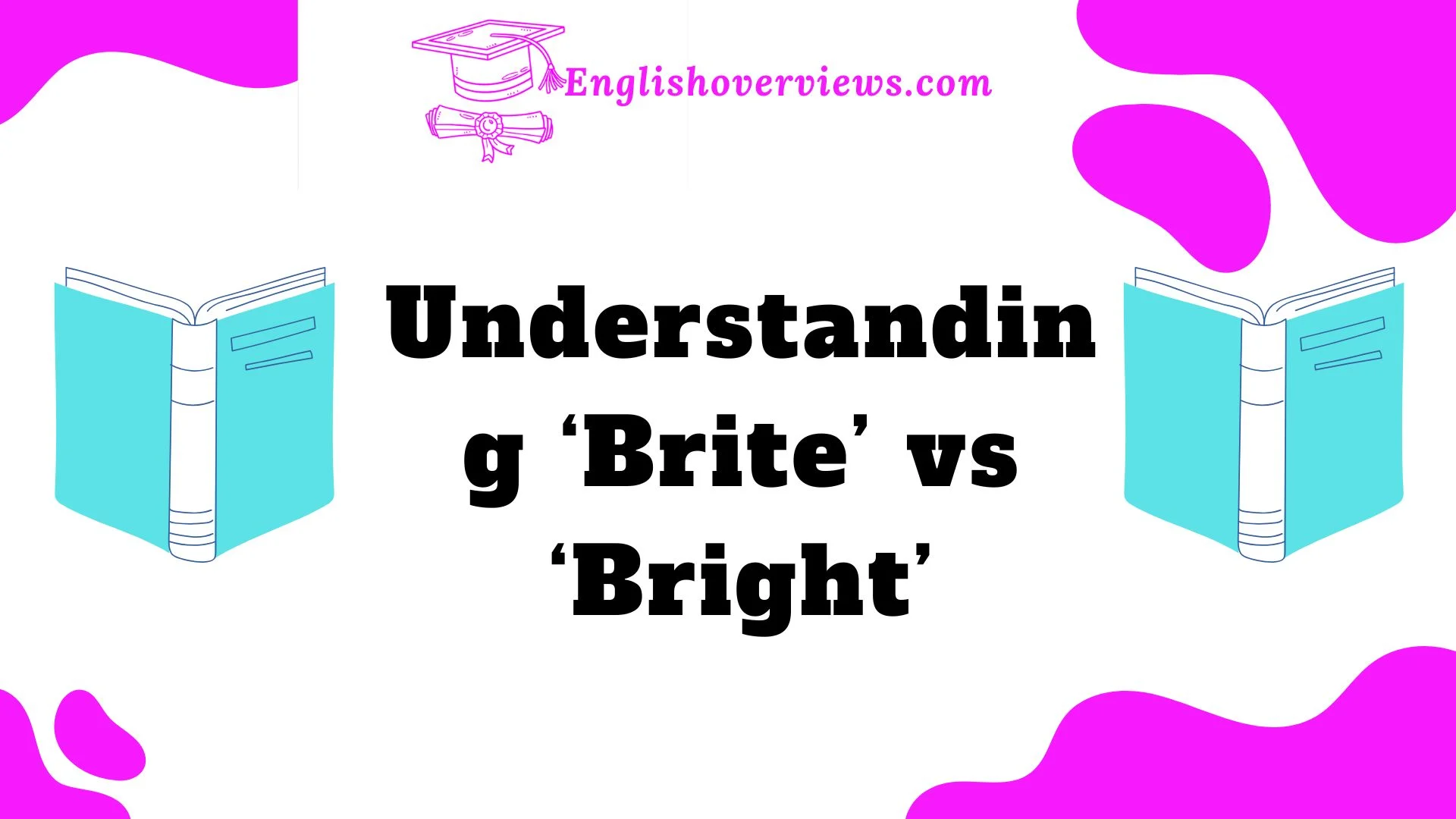Language is constantly evolving, and so are the words we use every day. ‘Brite’ and ‘bright’ are two such words that often confuse many people. Understanding ‘Brite’ vs ‘Bright’ While they may seem nearly identical in spelling, their usage, meaning, and context differ greatly. In this blog post, we
The Etymology of ‘Brite’ and ‘Bright’
To understand the difference between ‘brite’ and ‘bright,’ it’s essential to first explore the etymology of these words. Knowing their origins can give you a better appreciation for their current usage and meaning.
The Origin of ‘Brite’
The word ‘brite’ is an altered form of ‘bright.’ The spelling change from ‘bright’ to ‘brite’ typically appears in product names, trademarks, and other forms of branding. It is often used to imply something related to brightness, clarity, or energy, while simultaneously distinguishing the product or idea as modern or advanced.
For instance, ‘brite’ may be used in product names like ‘Brite-Lite’ or ‘SuperBrite,’ where the focus is on evoking a sense of superior brightness.
The use of ‘brite’ in this context reflects a marketing technique aimed at creating a catchy and appealing brand identity, rather than adhering to traditional grammar or spelling conventions.
The Origin of ‘Bright’
On the other hand, ‘bright’ has a much older and more established history in the English language. It traces its roots back to Old English, where it was spelled ‘beorht’ or ‘briht,’ both of which meant “illuminated” or “clear.” Over time, this word evolved to describe anything that gave off light, as well as intellectual sharpness or mental clarity.
The historical development of ‘bright’ has allowed it to be used across various contexts in modern English. Whether referring to the sun, a person’s intellectual capacity, or even a colorful object, ‘bright’ has retained its strong connection to light and energy.
Brite vs. Bright: Pronunciation and Spelling
While ‘brite’ and ‘bright’ might appear to be almost identical, the subtle differences between them can be crucial in certain situations. Let’s break down their pronunciation and spelling to understand these distinctions better.
Pronunciation
The pronunciation of ‘brite’ and ‘bright’ is almost the same, especially in casual conversation. Both words are pronounced with the long “i” sound, as in “eye” (/braɪt/).
However, ‘brite’ tends to be emphasized more in the context of branding, while ‘bright’ is the standard form used in everyday language. Although the two words sound the same, the spelling changes help signal their different meanings or intended uses.
Spelling Differences
The spelling of ‘brite’ is primarily seen in informal contexts, especially in marketing and branding, where companies seek to distinguish their products with unique names. It’s often chosen for its clean, modern look and sound.
- Bright: The more traditional spelling, used in all forms of writing—whether formal or informal.
- Brite: An alternative, often seen in advertisements, logos, or marketing materials to grab attention and stand out.
Despite the difference in spelling, ‘brite’ is not a formal alternative to ‘bright’ and is rarely used in standard prose.
Understanding the Meaning of ‘Brite’
Now that we know the origins and spelling differences, let’s dive into what ‘brite’ means. As mentioned earlier, ‘brite’ is used primarily in branding and advertising to convey a sense of modernity and visual appeal.
Example Sentences Using ‘Brite’
To make the concept of ‘brite’ clearer, let’s look at some example sentences:
- “This new Brite LED light bulb is more energy-efficient than traditional bulbs.”
- “The Brite screens on our phones make it easy to read even under direct sunlight.”
- “The Brite whiteboard markers offer sharper colors for presentations.”
In each case, ‘brite’ is associated with products that promise clarity or brightness, often invoking an image of modern technology or innovation.
Understanding the Meaning of ‘Bright’
Now let’s take a deeper look at ‘bright,’ a word you’re likely more familiar with. ‘Bright’ is a versatile adjective that can be used to describe both physical and abstract qualities.
Visual Brightness
In its most literal sense, ‘bright’ refers to a source of light. Whether you’re talking about the brightness of a star or the glare from a street lamp, ‘bright’ communicates how well something illuminates its surroundings.
Example Sentences:
- “The bright light from the sun hurt my eyes.”
- “She wore a bright red dress that caught everyone’s attention.”
Intellectual Brightness
Beyond its visual meaning, ‘bright’ is also used metaphorically to describe someone’s mental sharpness or intelligence. When someone is said to be “bright,” it means they are quick-thinking, clever, or academically gifted.
Example Sentences:
- “He’s a bright student with a promising future.”
- “She always has bright ideas during team meetings.”
Comparing ‘Brite’ and ‘Bright’ through Examples
Interior vs. Exterior: Clarifying the Distinctions
Let’s break down how ‘brite’ and ‘bright’ are used differently in various contexts. One way to understand the difference is by considering the interior vs. exterior usage of these words.
- ‘Brite’: Typically used to describe external products or ideas, especially in marketing and branding. For example, the name of a brite light bulb or a brite screen.
- ‘Bright’: Used more commonly for both internal and external situations. It could describe the literal brightness of a light (an external condition) or a person’s intelligence (an internal quality).
| Context | Brite | Bright |
| Physical Appearance | Brite LED lights, Brite screens | Bright sun, bright eyes |
| Intelligence | Rarely used for intelligence | Bright student, bright idea |
| Marketing | Brite used in product names | Bright used in everyday language |
As you can see, the use of ‘brite’ tends to be more limited to specific, commercial contexts. ‘Bright,’ however, enjoys broader application in describing physical objects, people, and abstract concepts.
Navigating Prepositional Use for Greater Precision in Language
Prepositions often help specify relationships between objects and other components of a sentence. In the case of ‘brite’ and ‘bright,’ their meanings are often clarified further by accompanying prepositions.
For example:
- Bright can be used in prepositional phrases like “bright with enthusiasm” or “bright on the horizon.”
- Brite, however, is less likely to appear in such phrases, as it’s more commonly seen as part of a brand or product name.
Common Use Cases: Brite vs. Bright
Let’s now take a look at some common use cases of both ‘brite’ and ‘bright’:
Brite Use Cases
- Advertising and Marketing: Products like Brite LED lights, Brite screens, and Brite paint are often marketed using this term to convey a sense of energy, innovation, or modern technology.
- Branding: Companies opt for the term ‘brite’ to stand out and create memorable, visually striking brand names.
Bright Use Cases
- Describing Light: Bright is commonly used to describe physical light, such as a bright room or bright streetlamp.
- Describing Intelligence: When talking about someone’s mental sharpness, bright is often used, e.g., “She’s a bright student.”
- Figurative Uses: Bright is often used to convey positivity, e.g., “a bright future” or “a bright idea.”
Conclusion: Which One to Use?
Choosing between ‘brite’ and ‘bright’ boils down to context. Use ‘brite’ primarily for commercial or branding purposes, especially when you want to convey a sense of modernity or clarity. On the other hand, ‘bright’ remains the standard spelling for everyday use, encompassing both literal and figurative meanings, from light to intellect.
By understanding these distinctions, you can make more precise language choices in your writing, whether you’re crafting a marketing message or describing the world around you. Keep these differences in mind, and you’ll be on your way to mastering the subtle nuances between ‘brite’ and ‘bright.’
FAQs
1. What is the difference between ‘brite’ and ‘bright’?
The main difference lies in their usage. ‘Bright’ is the standard word in the English language used to describe light, intelligence, or vividness. ‘Brite’ is a stylized version of ‘bright’ and is primarily used in branding, advertising, or product names to evoke modernity or clarity.
2. Can I use ‘brite’ in formal writing?
No, ‘brite’ is typically reserved for branding or product names. It’s not used in formal writing, academic papers, or standard communication. For formal contexts, you should always use ‘bright.’
3. Is the pronunciation of ‘brite’ different from ‘bright’?
No, the pronunciation of ‘brite’ and ‘bright’ is identical. Both words are pronounced with a long “i” sound (like the word “eye”), but the spelling differs based on context.
4. Why do brands use the spelling ‘brite’?
Brands use the spelling ‘brite’ because it stands out visually and creates a unique, modern feel. It’s a marketing tool designed to make products sound fresh and innovative, especially for items related to light or clarity.
5. Can I use ‘brite’ to describe a person’s intelligence?
No, ‘brite’ is rarely used to describe a person’s intellectual abilities. ‘Bright’ is the correct word when referring to someone’s intelligence, such as in “She’s a bright student.” ‘Brite’ is used primarily for products or branding.

English Overviews is a resourceful website dedicated to providing valuable content related to grammar and vocabulary. Muhammad Haroon has made notable contributions, sharing insights on various subjects, including WordPress themes and plugins. The primary goal of the site is to help users improve their English language skills effectively.











